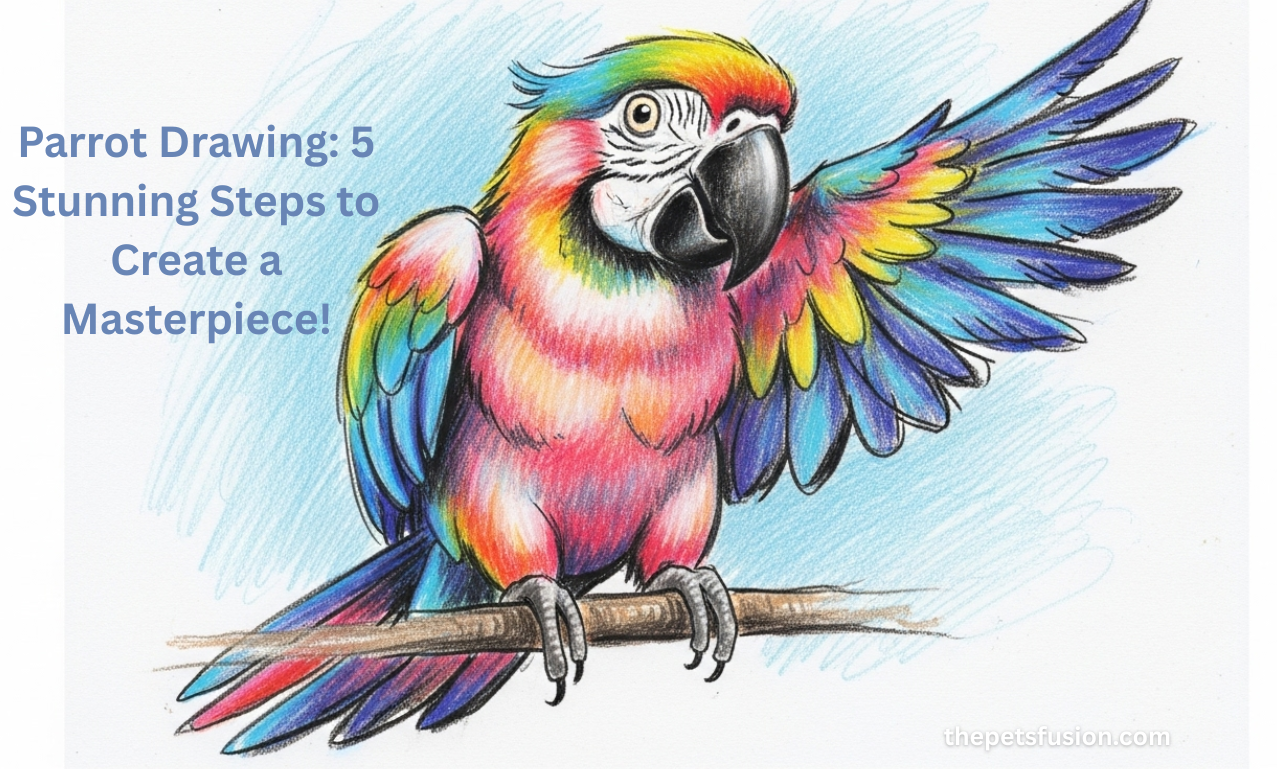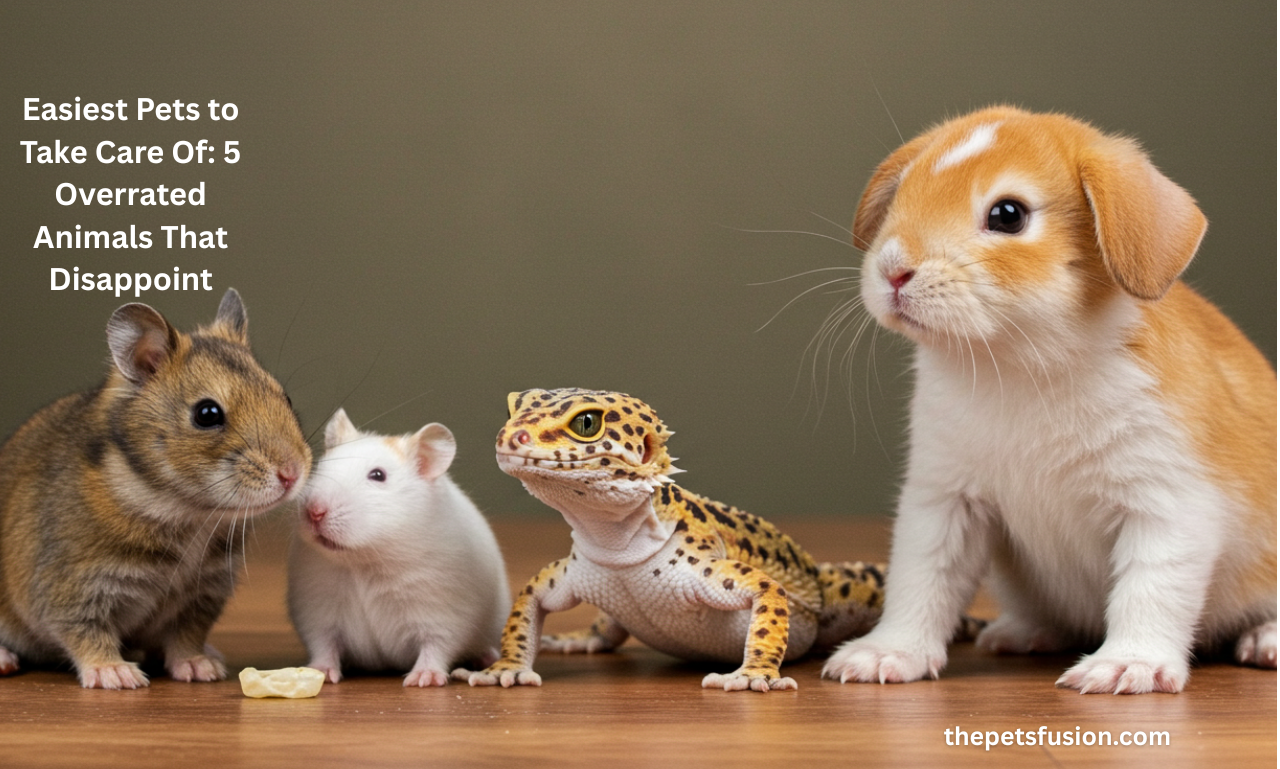Ever dreamed of having a low-maintenance pet that doesn’t bark, scratch the couch, or demand belly rubs at 3 a.m.? You might be wondering how to take care of a pet turtle, and the good news is—you’re not alone. Turtles are cool, calm, and collected, making them one of the most fascinating companions you can keep. But while they may seem easy to care for, they’re not as simple as putting them in a bowl of water and feeding them lettuce.
Whether you’re looking to build the perfect turtle tank, care for a rescue from the garden, or want to be the best reptile parent on the block, this guide breaks it down for real-life turtle lovers—no fluff, just 100% actionable steps to keep your turtle healthy, happy, and thriving. Let’s start with the essentials of turtle habitats, nutrition, wellness, and setup tips. You’ll discover the 7 vital turtle care tips every keeper should know—plus expert FAQs.
1. Is a Turtle the Right Pet for You?
Before we talk about tanks, filters, and food, we need to ask: Are turtles the right pet for you? Most people are unaware that turtles can live for 20 to 40 years, and some species can live even longer. This means you’re not just getting a nice-looking lizard; you’re choosing a pet that will be with you for a long time.
Pros of Having a Pet Turtle
- Low noise & low allergen — great for apartments or homes with kids
- They don’t shed, scratch furniture, or need daily walks
- Fascinating to watch—turtle aquarium setups can become living art
Cons (aka The Reality Check)
- Require UVB lighting, filtration, and regulated temperatures
- Weekly cleanings (especially for aquatic turtles) can be time-consuming
- Not cuddly—handling is minimal, and they don’t form “emotional bonds” like dogs or cats
If you’re looking for a decorative, low-interaction, yet fascinating animal, a turtle is perfect. But if you’re hoping for constant affection or a lap buddy, a pet tortoise might suit you better, or perhaps a different pet altogether.
2. Know Your Turtle Species Before Bringing One Home
If you’re searching for how to take care of a pet turtle, step one is identifying which turtle you’re welcoming into your life. Not all reptiles are created equal—as we learned, their needs vary dramatically based on species.
Aquatic Turtles
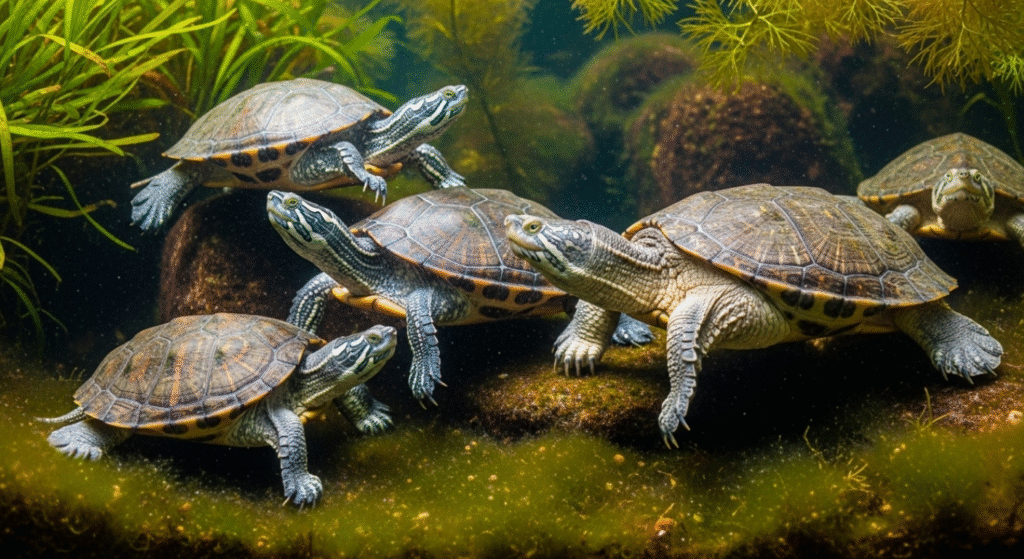
Species such as the Red-eared Slider and the Painted Turtle are well-suited for a turtle aquarium setup. These aquatic turtles spend most of their lives swimming and require:
- Large tanks (50–120+ gallons, depending on age)
- Powerful filters to handle water waste
- A basking area with heat and UVB lighting
Pros: Fascinating behaviors, strong swimmers, and interactive
Cons: Messy, water maintenance required, big tank needed
Semi-Aquatic & Terrestrial Turtles
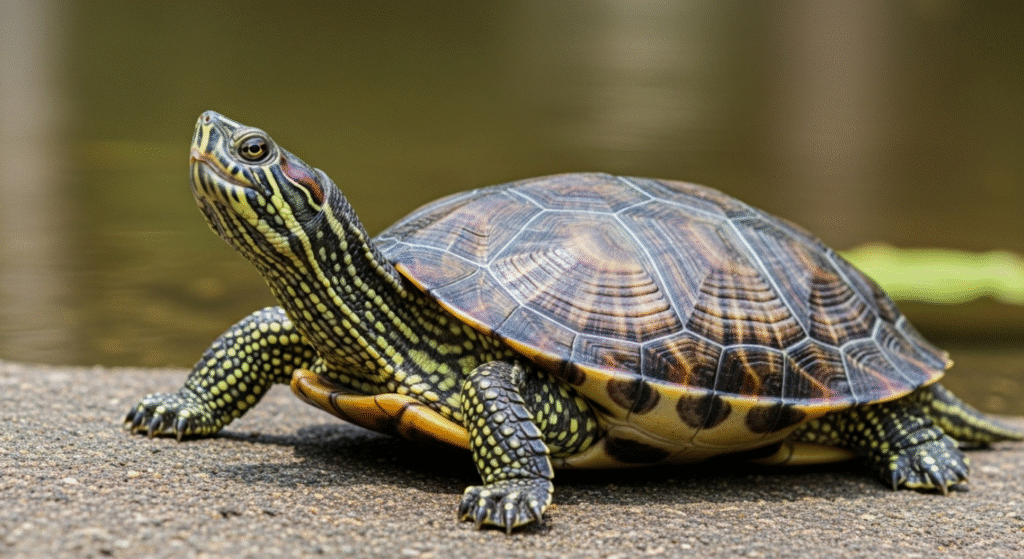
Think Box Turtles and Musk Turtles. These mostly land-based turtles need both dry zones and shallow water features.
- Roomy turtle habitats with dirt, logs, and secure hiding spots
- Shallow soaking dishes or ponds
- High humidity is required for species like musk turtles
Pros: Compact enclosures, easier water control
Cons: More complex terrarium setup, temperature monitoring
Pet Tortoise
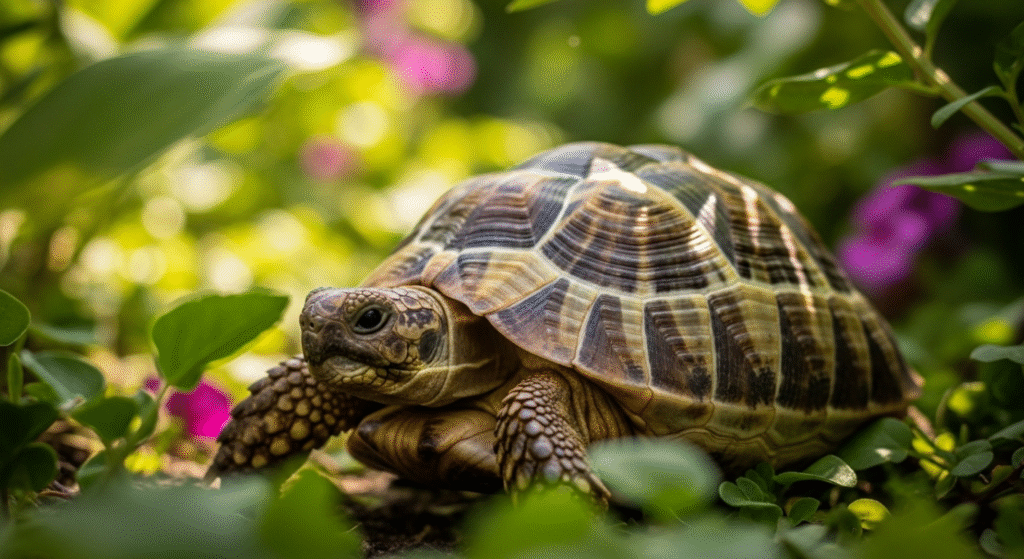
Species such as Russian Tortoises are true pet tortoises—land-lovers from start to shell.
- Require space to roam: trays, tables, or outdoor pens
- Mostly herbivorous diet
- Need UVB lighting and dry substrate
Pros: Long lifespans, engaging explorers, great for outdoor setups
Cons: Larger living spaces, potential long lifespan commitment
Legal & Lifespan Considerations
- Many species live 20–50 years, making them better suited for committed owners
- Some turtles (like sliders) are banned in select states
- Captive-bred is best—wild turtles face higher stress and health issues
Identifying your turtle species early means you can provide a turtle habitat that’s healthy, happy, and sustainable for the long haul.
3. Habitat Essentials: Tank, Table & Outdoor Pens
Once you’ve picked your species, the next step in how to take care of a pet turtle is creating a home that fits its lifestyle. A well-planned turtle aquarium setup or habitat isn’t just comfortable—it’s essential for your turtle’s health and happiness.
Aquatic Turtle Tank
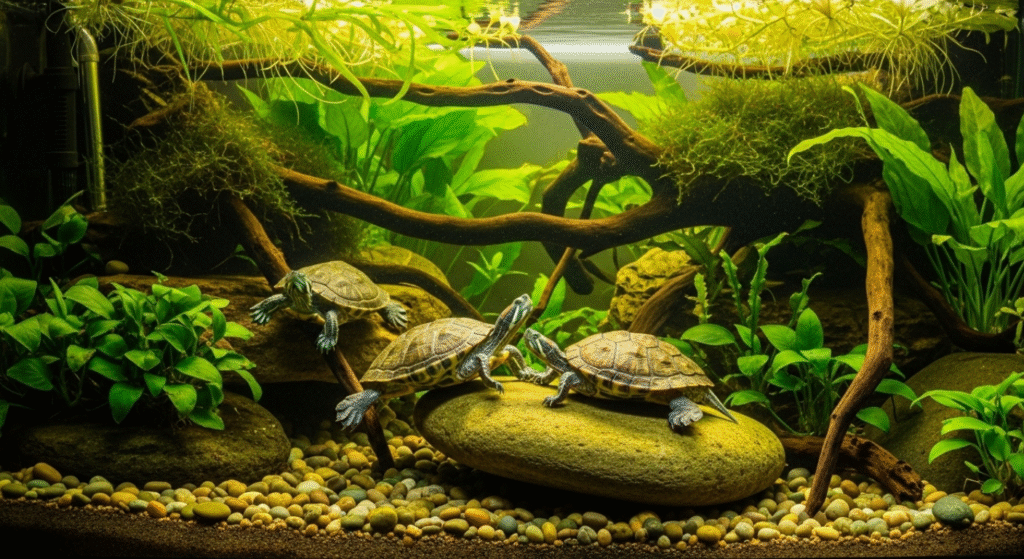
For aquatic turtles like sliders, your tank is everything. Here’s what you’ll need:
- Tank Size
- Juveniles: minimum 40 gallons
- Adults: 75–120 gallons, or 10 gallons per inch of shell
- Filtration System
- Power: at least 3× tank volume per hour
- Consider a canister filter—they’re quieter, more effective
- Water Heater
- Maintain 75–80°F (24–27°C) for your turtle’s comfort and digestion
- Basking Platform
- Use slate, driftwood, or reptile docks
- Ensure it stays dry above water
- Lighting Setup
- Heat lamp (85–95°F basking area)
- UVB bulb (changed every 6 months)
- Substrate Choice
- Bare bottom or large river rocks—avoid small gravel to prevent ingestion
- Decor & Hiding Spots
- Use non-toxic aquatic plants, driftwood, or PVC pipes to mimic natural environments
Semi-Aquatic or Terrestrial Habitat
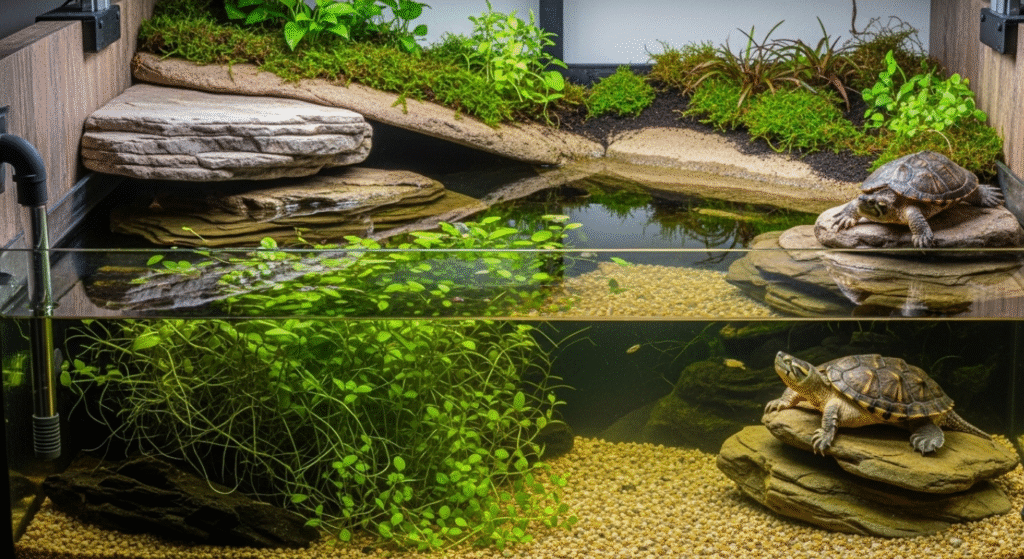
For box turtles and other semi-aquatic reptiles, your “tank” is more like a cozy land oasis:
- Enclosure Size
- At least 4 ft x 2 ft for one turtle
- Taller walls help retain humidity
- Substrate
- Use coconut coir, topsoil, and leaf litter
- Water Features
- A shallow dish for drinking and soaking
- Hiding Structures
- Provide logs, rocks, and caves for privacy and exploration
- Lighting & Heat
- UVB lamp above the enclosure
- Basking light for a 90–100°F hotspot
- Humidity Control
- Mist daily and add a humidity gauge
Outdoor Pens: Letting Them Soak in Sunshine
If you’re housing a pet tortoise or box turtle outdoors, an alfresco setup can be amazing:
- Fenced Enclosure
- Walls buried 6–12 inches deep to prevent digging escapes
- Shelters
- Provide insulated hideaways for shade and rain protection
- Climate Considerations
- Monitor for adequate temperatures; bring indoors if it’s too cold or hot
- Food Garden
- Plant edible greens like clover, dandelion, and hibiscus
- Safety Measures
- Keep pets and chemicals away
- Secure the top cover to deter predators
Habitat Setup Mistakes to Avoid
- Using filters meant for fish, turtles need a more substantial water flow
- Skipping UVB lighting leads to bone and shell issues
- Keeping turtles in tanks that are too small stunts growth and causes stress
- Adding gravel: ingestion hazard and digestion troubles
DIY Enhancements for Happy Turtles
- Floating platforms to add depth variation
- Misting systems to maintain tropical humidity
- Automated lights on timers for consistent day/night cycles
- Camera setup to monitor activity while you’re away
4. Feeding Your Turtle: What, When & How
A balanced diet is essential for maintaining the health of turtles. Knowing what your turtle eats and how often it eats affects how long it lives, how much energy it has, and how strong its shell is.
Understanding Turtle Dietary Types
Different species = different diets. Here’s how they break down:
- Aquatic turtles (e.g., red-eared sliders, painted turtles):
- Omnivores — eat plants, protein, and commercial food
- Semi-aquatic turtles (e.g., box turtles):
- Omnivores — prefer fruits, veggies, and insects
- Tortoises (not water-bound):
- Strict herbivores — mostly greens and weeds
What to Feed Aquatic Turtles
A balanced turtle aquarium setup needs equally balanced meals.
Daily Diet Example:
- Staple: Pellets or sticks (commercial turtle food)
- Protein (2–3× per week):
- Boiled egg white
- Earthworms
- Bloodworms
- Freeze-dried shrimp
- Vegetables (daily):
- Romaine lettuce, dandelion greens, kale
- Occasional Fruit: Small chunks of melon, berries
Tip: Soak pellets in tank water for easier digestion.
What to Feed a Pet Tortoise
Most pet tortoise species (e.g., Russian, Sulcata) thrive on a high-fiber, low-protein diet.
Ideal Foods:
- Grasses, clover, weeds
- Leafy greens (avoid spinach in excess)
- Hibiscus flowers
- Cactus pads
- Squash or carrots (sparingly)
Avoid:
- Dog/cat food
- Iceberg lettuce (low nutrition)
- Fruits (rare treats only—high sugar can harm the tortoise’s gut)
Semi-Aquatic or Box Turtles? Feed a Mix
These are the pickiest eaters of the bunch!
Feeding Ratio:
- 50% vegetables & greens
- 25% protein (insects, cooked meat)
- 25% fruit (berries, banana, mango)
Feeding Schedule by Age
Feeding is essential for how to take care of a pet turtle. Turtles require different types of food depending on their age and species. Let’s simplify it so you understand what to feed and when.
Hatchlings (0–6 Months Old)
Baby turtles are tiny but grow fast, so they need a high-protein diet to support their development. At this stage, feeding should be daily.
- Offer floating turtle pellets twice a day.
- Mix in small pieces of boiled egg, bloodworms, or feeder insects.
- Keep portions small—what they can eat in about 10–15 minutes.
Tip: Hatchlings thrive in clean turtle tanks, so remove uneaten food right after meals.
Juveniles (6 Months – 3 Years)
As your turtle grows, you can reduce feeding to every other day. This helps prevent overfeeding and obesity.
- Provide a balanced mix: 60% protein (worms, pellets), 40% fresh greens (like kale, dandelion).
- Add calcium supplements once or twice a week for strong shell growth.
- You can occasionally add fruit, but only in small amounts.
This is the perfect age to improve their turtle habitats with basking spots and UVB lighting.
Adults (3 Years and Older)
Adult turtles need less protein and more fiber. Feeding should be limited to 3-4 times per week.
- Focus on dark leafy greens like collard, mustard, or romaine lettuce.
- Include protein sources like boiled eggs, mealworms, or insects just twice a week.
- Avoid feeding fatty meats or dairy products—turtles can’t digest them well.
A well-balanced turtle aquarium setup is crucial for maintaining a healthy feeding routine at this stage.
Pet Tortoise Feeding Guidelines
Though not aquatic, a pet tortoise also follows an age-based diet.
- Most adult tortoises eat daily or five days a week, depending on the species.
- 80% of their diet should consist of fresh greens (such as hibiscus, clover, and dandelion).
- 10% can be vegetables, such as squash or zucchini.
- 10% may include fruit or edible flowers—used sparingly.
Tortoises thrive in warm, dry turtle habitats with lots of space to graze and walk.
Pro Feeding Tips
- Feed in a separate tank to reduce water pollution (aquatic turtles)
- Remove uneaten food after 30 minutes
- Sprinkle calcium + vitamin D3 powder 2× per week
- Watch for signs of overfeeding: fat limbs, algae growth, excess poop
Common Feeding Mistakes to Avoid
- Too much protein = shell deformities
- No UVB = poor calcium absorption, even with a great diet
- Feeding human food (cheese, bread, processed meat) — hard no!
- Overuse of fruits — sugar upsets gut balance.
Fun DIY Turtle Treats
- Veggie Skewers: Thread leafy greens through sticks for “foraging”
- Frozen Fruit Cubes: Puree fruit and freeze into ice trays for hot days
- Floating Worm Pouches: Wrap a few bloodworms in a lettuce leaf—makes feeding interactive!
5. Maintain Clean Water, Temperature & Lighting
Water Quality is Non-Negotiable
For aquatic turtles, consistent water quality isn’t optional—it’s essential:
- Use a powerful filter (3 times the tank volume/hour) to combat waste and odors.
- Remove leftover food within 15 minutes of feeding.
- Perform 25–50% water changes weekly, using dechlorinated water.
- Monitor pH (6.5–8.0) and temperature (75–80°F/24–27°C).
Thermal Comfort Zones
Turtles rely on external warmth to stay healthy:
- Basking Spot: 85–95°F under heat lamp.
- Water Temp: 75–80°F via submersible heater.
- Rest of Tank: 75–80°F ambient air.
Use digital thermometers to accurately track all zones.
Lighting & UVB: Shell Health Accelerator
UVB light is vital for Vitamin D3 and bone health:
- Provide 10–12 hours daily with a UVB bulb (5.0–10.0 strength).
- Replace bulbs every 6 months.
- Position lighting 12 inches above the basking area.
No UVB → risk of metabolic bone disease.
Cleanliness & Care Routine
A turtle’s home needs regular maintenance to prevent illness and stress.
Daily:
- Take away any leftover food within 15 minutes.
- Clean off poop or dirt from the water or surface.
- Check the water to see how clear it is and what the temperature is.
Weekly:
- Change 25–30% of the water in turtle tanks.
- Rinse filter pads without soap.
- Wipe down glass and décor to clear algae buildup.
Monthly:
- Deep clean entire habitat: remove and disinfect turtle aquarium setup, including platforms and hides.
- Soak and scrub UVB bulbs, and replace them if they are old.
- Replace substrate in terrestrial setups.
- Inspect the equipment, including heaters, timers, and lights.
6. Health Monitoring & When to Call the Vet
Turtles may mask illness—be a detective.
Signs of healthy turtles:
- Clear, alert eyes; bright color; regular feeding.
- Smooth shell without pits or foul odor.
Warning signs:
- Sunken eyes, nasal discharge, wheezing → possible respiratory infection.
- Shell softening, pyramiding → nutritional/scurvy-like issues.
- Swollen limbs or skin lesions.
- Loss of appetite or lethargy.
If you notice any symptoms, please consult a reptile veterinarian promptly. Swift treatment prevents a severe decline.
Safe Handling & Social Time
Turtles aren’t lap pets—but they don’t need to be cold.
- Always wash your hands before and after handling.
- Support the body with both hands; never pick up by the tail.
- Keep handling to 10-15 minutes and do it only after feeding.
- Children should be supervised and taught how to use gentle methods.
- Turtles can notice when you are around after some time, but they don’t develop feelings like dogs do.
7. Seasonal Care & Temperature Adjustments
Indoor Turtles:
- Maintain consistent temps year-round.
- Avoid drafts and excessive heating.
Outdoor Turtles or Pet Tortoise:
- Check climate suitability; turtles need temperatures above ~60°F.
- Allow mild brumation under vet guidance, if appropriate.
- Move indoors early in the fall if temperatures drop.
Don’t miss: Parrot Drawing: 5 Stunning Steps to Create a Masterpiece!
FAQs
What is the best pet turtle for beginners?
If you’re new to turtle care, consider a red-eared slider or a box turtle as a suitable option. They’re hardy, widely available, and adapt well to indoor habitats. These turtles are easier to feed and require manageable setups, especially in basic turtle tanks.
Tip: Avoid exotic species until you’ve mastered basic turtle care.
Is keeping a turtle at home good or bad?
It depends on how committed you are. Keeping a turtle at home can be a peaceful, educational experience—but only if you provide the right turtle habitats, lighting, and filtration. If neglected, they can suffer from shell rot, malnutrition, or stress.
Good: Low noise, low allergies, long lifespan
Bad: Messy tanks, requires UVB lights, long-term care
How do you take care of a turtle found outside?
You should never keep a wild turtle unless it’s injured and needs temporary help. Wild turtles are used to roaming and may carry parasites. If you find one, gently place it off the road in the direction it was heading.
If necessary (due to injury):
- Please place it in a secure, shallow box
- Offer water and leafy greens
- Contact a wildlife rescue ASAP
Can I keep my turtle in a bowl or plastic container?
No—turtle tanks need filtration, heaters, UVB lighting, and swimming space. A plastic bowl will stunt growth, cause stress, and may lead to illness. Get a good turtle aquarium that holds 10 gallons of water for every inch of the turtle’s shell.
How often should I clean the turtle tank?
A spot clean should happen every 2–3 days, and full water changes (30–50%) should be done weekly. A sound filtration system makes this easier. Overfeeding can lead to cloudy water, so adjust portions to keep the water clean for longer.
How long do turtles live as pets?
Most pet tortoises and turtles live 20 to 50 years, but some can live over 80! They’re not short-term pets—you’re signing up for a lifelong companion—plan for long-term care and vet visits.
Do turtles need light at night?
No, they don’t. Turtles need a day-night cycle to thrive. Use a UVB light during the day (10–12 hours), and let the tank go dark at night. Constant light can cause stress and disrupt their behavior.
Conclusion
You’ve learned the essentials of how to take care of a pet turtle—from selecting the right species to setting up habitats, feeding, cleaning routines, health monitoring, safe handling, and seasonal care. Turtles aren’t impulse pets—they’re a long-term commitment that, when done right, offers decades of fascination and rewards.
You now have the tools to build a thriving setup, prevent illness, and enjoy life with your shellfish friend. Save this guide, share pictures of your turtle, drop your questions below, and subscribe for more beginner reptile wisdom. Your turtle’s journey is just beginning—and we’re happy to be a part of it!





